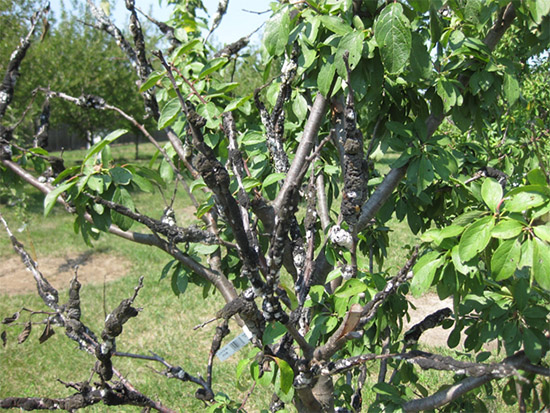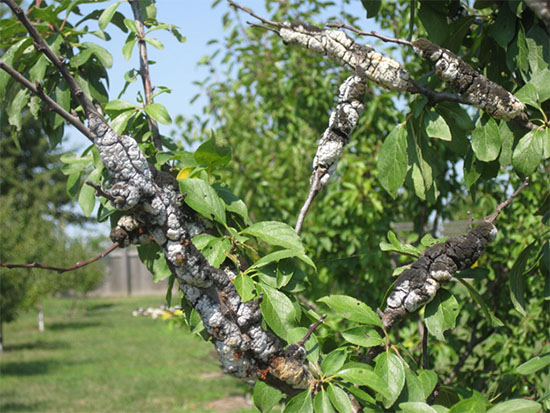Issue 11, July 11, 2016
Black Knot
The rationale behind the name "Black Knot" is self-evident upon first witnessing it. Black knot is a fungal disease that affects most cultivated and wild Prunus species in the United States, including cherry, plum, and chokecherry trees. The disease is caused by the fungus Apiosporina morbosa (also known as Dibotryon morbosum), and can be incredibly destructive once established. Symptoms are not obvious in the early stages.

Black knot.
Black knot affects the woody parts of the trees, and primarily girdles twigs. The characteristic knots produced by the fungus can be highly variable in size depending on the age of infection and the size of the twig. Early in the season the knots are an olive green color. As fall approaches they become corkier and take on the characteristic black color. The knots may also acquire a white discoloration as the season progresses due to a parasitic fungus growing on them. The knots grow perennially, and can get as large as a foot long. Foliage at the other end of the infected woody tissue will eventually wilt, and once infections have completely girdled the tissue foliage may fail to leaf out. In most cases the damage is purely cosmetic and the fungus will not kill the tree. However it does cause considerable stress to the tree, making it more susceptible to other pests. Infected branches often have poor fruit set.

Black knot closeup.
Management for this disease is primarily achieved through cultural means. When purchasing plants try to find certified disease free stock, and check them for any obvious symptoms. Resistant cultivars are available for most ornamental and edible Prunus species as well. When planting do not choose a site near any known infections, especially if they are unmanaged. Wild Prunus hosts do exist.
Scout trees regularly to begin management before the disease becomes established. If an infection does occur, pruning out knots is the best strategy. Knots are easily seen in the winter time when the tree is dormant and defoliated, and knots should be pruned out before they release spores in springtime. Cuts should be made 6-8" below the knot, and tools should be sterilized in 70% alcohol or 10% bleach between cuts to avoid spreading the fungus.
Knots can still produce and release spores when removed from the tree. They should be burned, disposed of in a closed container, or removed from the site. Unfortunately chemical options are limited in Illinois, and no fungicides are currently labeled for use against this disease. Thus, following the other management recommendations is especially important. (Sean Mullahy, Diane Plewa)
Authors:
Diane Plewa
Sean Mullahy